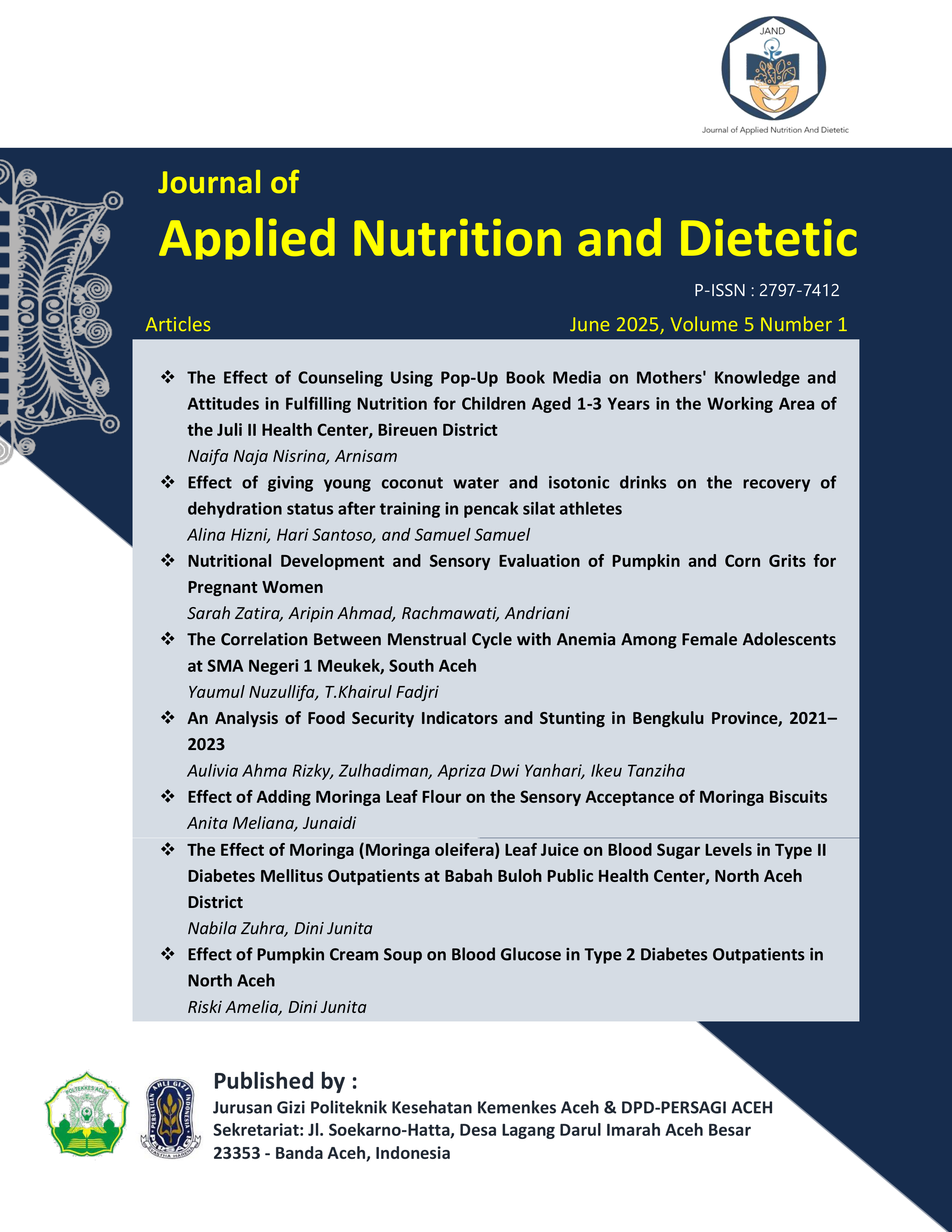The Correlation Between Menstrual Cycle with Anemia Among Female Adolescents at SMA Negeri 1 Meukek, South Aceh
DOI:
https://doi.org/10.30867/jand.v5i1.223Kata Kunci:
anemia, body mass index, female adolescents, menstrual cycleAbstrak
Anemia is a condition characterized by a reduction in the number or size of red blood cells or a decrease in hemoglobin (Hb) concentration below normal levels. The menstrual cycle is measured by the interval between the first day of one menstruation and the first day of the next. Body Mass Index (BMI) is an anthropometric indicator used to assess nutritional status, particularly in individuals over the age of 18.This study aimed to examine the correlation between menstrual cycle patterns and Body Mass Index (BMI) with the incidence of anemia among female adolescents at SMA Negeri 1 Meukek, South Aceh. This was an analytical survey study with a cross-sectional design. A total of 113 students from SMA Negeri 1 Meukek served as the population, and 53 students were selected as the sample using the Slovin formula and random sampling. Data were collected using a questionnaire, a microtoise for height measurement, a digital scale for weight, and the Easy Touch GCHb 3-in-1 device to measure hemoglobin levels. Bivariate analysis was conducted to assess associations. The analysis showed no significant correlation between BMI and the incidence of anemia (p = 0.213 > α = 0.05), indicating that BMI is not associated with anemia in this population. However, a significant correlation was found between menstrual cycle irregularities and anemia (p = 0.004 < α = 0.05). Based on these findings, it is recommended that schools and health authorities increase awareness and education on menstrual health and anemia prevention among adolescent girls.
Referensi
Adriani, M., & Wirjatmadi, B. (2014). The role of nutrition in the life cycle. Jakarta: Kencana.
Andriana, A., Andriana, N., & Andria. (2018). Factors affecting menstrual cycles in students at Pasir Pangaraian University. Journal of Maternity and Neonatal, 2(2), 271–279.
Anindita, P., Darwin, E., & Afriwardi. (2016). The relationship between daily physical activity and menstrual disorders in students of the Faculty of Medicine, Andalas University. Jurnal Kesehatan Andalas, 5, 522–527.
Arisman. (2010). Nutrition in the life cycle. Jakarta: EGC Medical Book Publisher.
Basic Health Research. (2010). 2010 Basic Health Research Results Report. Jakarta: National Institute of Health Research and Development.
Basic Health Research. (2013). 2013 Basic Health Research Results Report. Jakarta: National Institute of Health Research and Development.
Briawan, D., & Hardiansyah. (2010). Non-food risk factors for anemia in women of childbearing age (15–45 years) in Indonesia. Pangan dan Gizi Masyarakat (PGM), 33(2), 102–109.
Felicia, F., Hutagaol, E., & Kundre, R. (2015). Relationship between nutritional status and menstrual cycle in young girls at PSIK FK UNSRAT Manado.
Fikawati, S., et al. (2017). Nutrition for children and adolescents. Depok: Rajawali Press.
Kusmiran, E. (2011). Reproductive health for adolescents and women. Jakarta: Salemba Medika.
Morris, J. C. (2014). Guidelines for nutrition assessment & documentation. Jakarta: EGC.
Oktaviana, F. (2018). The effect of menstruation on the performance of athletes at the Lampung Student Education and Training Center (PPLP) (Undergraduate thesis, University of Lampung, Faculty of Teacher Training and Education).
Par’i, H. M. (2016). Assessment of nutritional status. Jakarta: EGC.
Permaesih, D., & Susilowati, H. (2005). Factors affecting anemia in adolescents. Buletin Penelitian Kesehatan, 33(4), 162–171.
Rati, S. A., & Jawadagi, S. (2012). Prevalence of anemia among adolescent girls studying in selected schools. International Journal of Science and Research (IJSR), 3(8).
Santi, D. R., & Pribadi, E. T. (2018). Menstrual disorders condition of patients treated at UIN Sunan Ampel’s Primary Clinic. Journal of Health Science and Prevention, 2(1), 14–21.
Silalahi, V., Aritonang, E., & Ashar, T. (2016). The potential of nutrition education in increasing nutrition intake of anemic adolescent girls in Medan City. Jurnal Kesehatan Masyarakat, 11(2), 295.
Supariasa, I. D. N., Bakri, B., & Fajar, I. (2012). Assessment of nutritional status. Jakarta: EGC.
Tarwoto, & Wasnidar. (2014). Anemia pocket book in pregnant women: Concept and management. Jakarta: Tim.
WHO. (2017). Global nutrition targets 2025: Anaemia policy brief. World Health Organization. http://apps.who.int/iris/bitstream/10665/148556/1/WHO_NMH_NHD_14.4_eng.pdf
Wijaya, A. S., & Mariza, Y. P. (2013). Medical surgical nursing (adult nursing). Yogyakarta: Nuha Medika.
U.S. Department of Health and Human Services, Office on Women’s Health. (n.d.). Menstruation and the menstrual cycle. https://www.womenshealth.gov/menstrual-cycle
Unduhan
Diterbitkan
Cara Mengutip
Terbitan
Bagian
Lisensi
Hak Cipta (c) 2025 JAND: Journal of Applied Nutrition and Dietetic

Artikel ini berlisensiCreative Commons Attribution-ShareAlike 4.0 International License.











